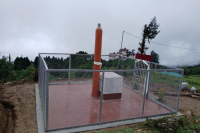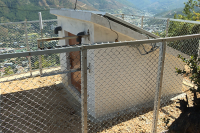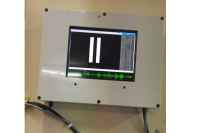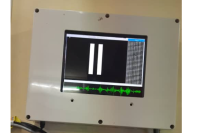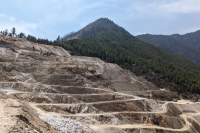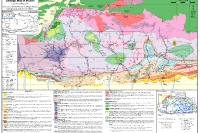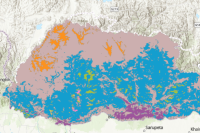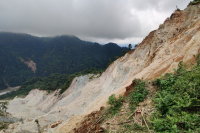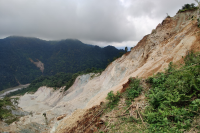Geoscientific information
National Land Commission Secretariat
GNSS Stations (CORS) Category: Common
The Continuously Operating Reference Stations (CORS) Network provides Global Navigation Satellite System (GNSS) data, supporting three dimensional positioning, meteorology, space weather, and geophysical applications throughout the Bhutan.
Keywords: [#cors#station#dzongkhag]
National Soil Services Centre
Soil Available Phosphorus Map of Bhutan Category: Common
This dataset contains the spatial distribution of soil available phosphorus content across Bhutan.
Keywords: [#Farming#Soil#Agriculture]
National Soil Services Centre
Soil Base Saturation Map of Bhutan Category: Common
This dataset contains the spatial distribution of Soil Base Saturation content across Bhutan.
Keywords: [#agriculture#soil#farming]
National Soil Services Centre
Soil Bulk Density Map of Bhutan Category: Common
This dataset contains the spatial distribution of Soil Bulk Density content across Bhutan.
Keywords: [#Agriculture#Farming#Soil]
National Soil Services Centre
Soil Exchangeable Calcium Map of Bhutan Category: Common
This dataset contains the spatial distribution of Soil Exchangeable Calcium levels across Bhutan.
Keywords: [#Farming#Soil#Agriculture]
National Soil Services Centre
Soil Cation Exchange Capacity Map of Bhutan Category: Common
This dataset contains the spatial distribution of Soil Exchange Capacity levels across Bhutan.
Keywords: [#Agriculture#Farming#Soil]
National Soil Services Centre
Soil Exchangeable Magnesium Map of Bhutan Category: Common
This dataset contains the spatial distribution of Soil Exchangeable Magnesium levels across Bhutan
Keywords: [#Farming#Soil#Agriculture]
National Soil Services Centre
Soil Organic Carbon Map of Bhutan Category: Common
This dataset contains the spatial distribution of soil organic carbon content across Bhutan.
Keywords: [#Farming#Soil#Agriculture]
National Soil Services Centre
Soil Exchangeable Potassium Map of Bhutan Category: Common
This dataset contains the spatial distribution of Soil Exchangeable Potassium levels across Bhutan.
Keywords: [#Farming#Soil#Agriculture]
National Soil Services Centre
Soil Exchangeable Sodium Map of Bhutan Category: Common
This dataset contains the spatial distribution of soil exchangeable sodium content across Bhutan.
Keywords: [#Farming#Soil#Agriculture]
National Soil Services Centre
Soil pH Map of Bhutan Category: Common
This dataset contains the spatial distribution of soil pH content across Bhutan.
Keywords: [#Farming#Soil#Agriculture.]
National Soil Services Centre
Soil Total Clay Map of Bhutan Category: Common
This dataset contains the spatial distribution of soil total clay content across Bhutan.
Keywords: [#Farming#Soil#Agriculture]
National Soil Services Centre
Soil Total Exchangeable Bases Map of Bhutan Category: Common
This dataset contains the spatial distribution of soil total exchangeable bases content across Bhutan.
Keywords: [#Farming#Soil#Agriculture]
National Soil Services Centre
Soil Total Nitrogen Map of Bhutan Category: Common
This dataset contains the spatial distribution of soil total nitrogen levels across Bhutan.
Keywords: [#Farming#Soil#Agriculture]
National Soil Services Centre
Soil Total Sand Map of Bhutan Category: Common
This dataset contains the spatial distribution of soil total sand content across Bhutan.
Keywords: [#Farming#Soil#Agriculture]
National Soil Services Centre
Soil Total Silt Map of Bhutan Category: Common
This dataset contains the spatial distribution of soil total silt content across Bhutan.
Keywords: [#Farming#Soil#Agriculture]
National Soil Services Centre
Soil Type (Class) Map of Bhutan Category: Common
This dataset is the soil type map of Bhutan. It represents the occurrence and distribution of different types of soils in Bhutan. The soil types listed in it are based on the World Reference Based (WRB) classification system of soil classification.
Keywords: [#Farming#Soil#Agriculture.]
National Soil Services Centre
Soil Available Potassium Map of Bhutan Category: Common
This dataset contains the spatial distribution of available soil potassium levels across Bhutan.
Keywords: [#agriculture#farming#soil]
Department of Geology and Mines
Source Monitoring Station Category: Open
The establishment of the earthquake monitoring station commenced in 2015 and was successfully completed in 2019. Its primary objective is to disseminate crucial earthquake-related information to enhance public awareness and preparedness. Recently, the Department of Geology and Mines (DGM) has been processing waveform data to verify earthquake occurrences. This analysis plays a vital role in generating a seismicity map, which helps identify regions prone to seismic activity. Furthermore, these efforts contribute to delineating possible active faults within the country, strengthening the understanding of Bhutan’s seismic landscape and supporting disaster mitigation strategies.
Keywords: [#Geophysics#Earthquake#station]
Department of Geology and Mines
Dzongkhag Intensity Meter Station Category: Open
To monitor and assess ground shaking intensity at specific sites during an earthquake, intensity meters are installed in every Dzongkhag. These meters detect seismic activity to support post-disaster analysis. Stations are primarily located in populated areas to facilitate effective response and relief measures in regions prone to severe damage.
Keywords: [#Earthquake Station]
Department of Geology and Mines
Gewog Intensity Meter Station Category: Open
To effectively monitor and assess the intensity of ground shaking during seismic events, intensity meters have been strategically installed across all gewogs, with the exception of four: Soe and Lingzhi in Thimphu Dzongkhag, and Laya and Lunana in Gasa Dzongkhag. These instruments are designed to detect and record seismic activity in real time, providing critical data that supports detailed post-earthquake analysis and damage assessment.The placement of these stations is prioritized in densely populated or high-risk areas to enhance situational awareness during emergencies. By capturing localized intensity measurements, they play a vital role in guiding timely and informed response actions, facilitating the coordination of relief efforts, and strengthening disaster preparedness in regions susceptible to significant seismic impact.
Keywords: [#Geophysics#Earthquake#station#gewog]
Department of Geology and Mines
Location of Quarries in the Country Category: Open
Bhutan's mining sector primarily extracts industrial minerals like limestone, dolomite, gypsum, marble, ferro-silicon grade quartzite, iron ore, talc, and various construction materials. Due to favorable geological formations and easier market access, the majority of mines and quarries are concentrated in the southern foothills and lower Himalayas, with the central and northern high-altitude regions remaining largely inactive. The predominant extraction method is surface mining. Bhutan's mining policies are uniquely designed to balance economic prosperity with environmental preservation and social equity, aiming to promote in-country value addition and align the sector with the nation's development philosophy.
Keywords: [#mining#quarry#location]
Department of Geology and Mines
Geologic Map of Bhutan Category: Open
Featured in the Journal of Maps in 2011, this geological map presents a newly compiled 1:500,000-scale representation of Bhutan, along with neighboring areas in India and southern Tibet. Assembled from the most recent and comprehensive mapping datasets available at the time, it offers a significantly enhanced level of structural detail compared to earlier geological maps of the region. Bhutan’s geology is broadly categorized into four major lithological units, arranged from south to north: the Siwalik Group, the Lesser Himalayan Zone, the Greater Himalayan Zone, and the Tethyan Himalayan Zone. Alongside this, the antiformal tectonic window exposing Lesser Himalayan units with the Greater Himalaya, and the synformal klippe of Tethyan Himalayan units—both regarded as characteristic structural features of the Himalayas are also mapped in the Bhutanese Himalaya.
National Soil Services Centre
Soil Texture Map of Bhutan view Category: Common
This dataset is the soil texture map of Bhutan. It represents the occurrence and distribution of different types of soil texture in Bhutan. The USDA system of soil texture classification was used to classify different types of soil texture.
Keywords: [#Agriculture#Farming#Soil]
Department of Geology and Mines
Landslide Inventory of Samdrupjongkhar Dzongkhag Category: Open
Samdrup Jongkhar Dzongkhag, situated in southeastern Bhutan, is highly prone to landslides due to its fragile geology, high monsoon rainfall, and increasing infrastructure development in steep terrain. Recognizing its vulnerability, field validations were carried out over two consecutive phases. The first phase, conducted in 2021-2022, was limited in coverage due to logistical constraints. A more targeted second phase (2022–2023) focused on areas with significant impacts on settlements and infrastructure.Out of the 11 gewogs, landslide data were collected from 8 gewogs, with Dewathang Gewog accounting for the highest share (35%) of the total. Field verification showed that 87% of the landslides are active, and the majority are located along roads, directly affecting transportation and nearby communities.The primary triggering factors include road undercutting, intense rainfall, and fragile geological conditions. The landslides are mainly composed of phyllite, shale, siltstone, coal, gneiss, and quartzite, rock types that are often highly weathered, fractured, and susceptible to failure, especially during monsoon periods.Although validations were conducted over two phases, full coverage of the Dzongkhag was not achieved due to time, resource limitations, and difficult terrain. The current inventory emphasizes high-impact areas, while remote or less accessible regions remain unassessed, highlighting the need for future comprehensive risk mapping and mitigation planning.
Keywords: [#Geohazards]
Department of Geology and Mines
Landslide Inventory of Samtse Dzongkhag Category: Open
Samtse Dzongkhag, located in Bhutan’s southern foothills, is among the most landslide-prone regions in the country due to its fragile geology, intense monsoon rainfall, and increasing anthropogenic activities. Geologically, the area lies within the tectonically active Siwalik and Lesser Himalayan zones and is traversed by major fault systems, including the Main Frontal Thrust (MFT) and Main Boundary Thrust (MBT), as well as numerous local faults and folds. These structural features have fractured and deformed the rock mass, which is primarily composed of highly to completely weathered phyllite, quartzite, sandstone, and siltstone, all of which are weak and highly susceptible to failure when saturated.With annual rainfall often around 4,000 mm, coupled with widespread slope disturbances from road construction, riverbank erosion, deforestation, and settlement expansion, landslides have become a recurring hazard. Field validation confirmed that 9 out of 15 gewogs, particularly Samtse and Phuentshopelri, are severely impacted. A total of 59 landslides were documented, most of which remain active and are concentrated along thrust zones. Among these, 16 landslides (27%) were identified as critical due to their high vulnerability to settlements and key infrastructure.The study focused on landslides with direct or observable impacts on settlements and infrastructure. Remote or less accessible areas were excluded due to time and logistical constraints but should be included in future assessments, considering the evolving and uncertain nature of landslide hazards.
Keywords: [#Geohazards]
Department of Geology and Mines
Landslide Inventory of Zhemgang Dzongkhag view Category: Open
Zhemgang Dzongkhag, located in central Bhutan, exhibits localized but significant landslide activity, driven by steep terrain, fragile lithology, and human-induced disturbances. Out of eight gewogs, landslide data were collected from three gewogs, with a notable 77% of the events concentrated in Singkhar Gewog, highlighting a high-risk zone in the district.The lithology around the recorded landslides includes gneiss, granite, schist, phyllite, and quartzite, which under the deformed and fractured conditions are particularly vulnerable to failure when saturated by rainfall. These geological weaknesses are compounded by slope modifications from developmental activities.A total of 13 landslides were recorded. Among them, 54% are active, 23% suspended, and 23% dormant, reflecting varying levels of instability. The main triggering factors identified were road undercutting and climatic influences, especially intense rainfall. Two landslides located below Singkhar Primary School and in Laylang under Ngangla Gewog were classified as critical due to their proximity to settlements, school infrastructure, and roads used by commuters.Data were collected from only three gewogs due to limited time and resources. Remote or less accessible areas were not surveyed, and their landslide risk remains undocumented. These areas should be included in future assessments to support comprehensive hazard mapping and mitigation planning.
Keywords: [#Geohazards]
